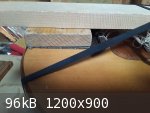
Dr. Oud - 10-22-2019 at 10:25 AM
The thing is...when the action raises up it's not from a warped neck, it's from a warped body. The string tension over time causes the body to bend,
increasing the angle of the neck so the action raises. There are a number of solutions:
1. add an extended fingerboard on top ot the original. This raises the fingerboard up and can consequently lower the action. About 1/8 inch-5mm will
usally do. Too thick can make the neck feel fat.
2. Reset the neck angle. This is necessary if the action is radically high, say 1/4 inch-10mm. The neck is removed, then the end of the neck is sanded
to a set the neck back for a good action. Pretty radical operation.
3. Bend the body back. This is done all the time by guitar technicians for warped necks. The oud can be strightened but it is the body that must be
bent. A pad is placed atop the tail to clear the bridge, and a stiff board spans from the top edge of the neck to the tail pad. A clamp is placed on
the neck next to the body joint and pressure applied gradually. Don't over clamp or you can pop the neck joint. A heating pad is wrapped around the
body near the neck and secured with rubberbands or string. The pressure is applied just enough to see movement, not too much. Leave this heated over
night, checking the pressure of the clemp. If is loosens, apply a little more pressure. There will be some spring back. The next day remove the
heating pad but keep the clamp on until the back cools down. You shou;d be good to go, If the action is too low, clamp the board at the top of the
neck and use wedges at the neck block to force the body down to raise the action.
Turkish action should be about 2mm, Arabic 3mm (longer string length)



tkmasuda - 11-5-2019 at 10:42 AM
So this is meant to straighten the soundboard rather than the neck joint? I stopped playing my instrument because the action has gone from 3.5 to 4.0
over the past couple of years, and maybe this is the answer.
Brian Prunka - 11-5-2019 at 01:46 PM
Doc, what about if the existing fingerboard is thick enough to shave down? From my experience, if the fingerboard is thick, you have some room to
shave it down, you can change the angle enough to lower the action (shaving it down more towards the nut and less towards the body).
MoH - 5-7-2020 at 10:16 PM
I'm considering doing this for my oud, but first wanted to make sure I understood exactly how this worked. It seems like the clamp pushes the oud
closer to the board at the neck joint which tilts the neck back. Does this mean this fix wouldn't work if the neck was already angled back relative to
the face? Or I guess that's not an issue since there's good clearance between the long board and the neck so you could angle it back quite a bit.
Why exactly is this considered bending the whole oud back and not just the neck relative to the body?
And where do you find a heating pad like that?
EDIT: Actually, I think I get it now. Basically, you're applying the same method as in this video:
https://youtu.be/ZtKzL3n0fgc?t=95 (1:35)
but instead of just bending the neck, it's the whole oud. That's why you're saying you're bending the whole body rather than the neck. Why not then
put another small block at the end of the neck? And are there any alternatives to the heat pad? Hair dryer? Clothes iron?
yorch1 - 5-14-2020 at 05:34 PM
Nice!
MoH - 5-14-2020 at 07:56 PM
I ended up trying this on my oud about a week ago, and it actually worked! I used an old space heater to provide heat and laid the oud on its side by
propping it up with some assorted items. Not sure if this threw things off balance, but it doesn't seem to have caused any noticeable problems. Before
and after pics here (I believe the before pic is zoomed in a little less than the after pics, so the absolute visual difference in string height might
not be as apparent as in real life):
https://flic.kr/s/aHsmNe2Q7w
After removing the clamp and putting on the strings, they were so low that there was considerable slap against the fingerboard, so I lifted them up at
the bridge and now they are at a comfortable height without any buzzing. I was also worried this method would just weaken the neck joint and cause the
strings to raise again, but so far, nothing has changed. This seems like a great method to get the action down without having to saw into the neck.
Thanks, Dr. Oud!
